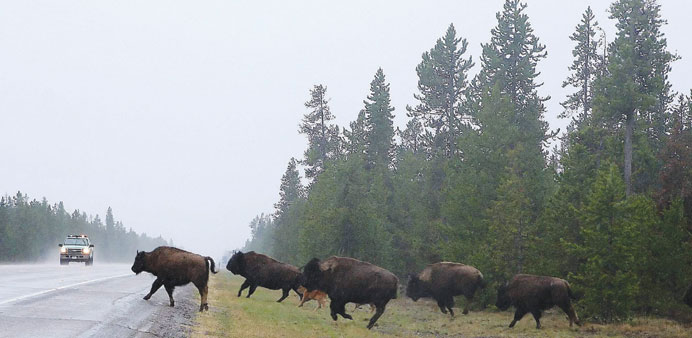|
One bison after another trotted along the highway - a long string of the animals coming at the stream of car traffic entering Yellowstone National Park. The camera wobbled a bit, the bison shook and flared their nostrils. |
YouTube video blogger Tom Lupshu, pointing out that animals have much sharper senses than people, said earlier this month that the bison seemed to feel the presence of something violent and deadly.
Social networks were swirling with the theory that the bison sensed an outbreak of the Yellowstone supervolcano under which lies a vast magma chamber.
If an earthquake really happened there the results would be devastating for the entire planet. Just a few days before, a strong quake shook Chile. Are the world’s tectonic plates in a state of imbalance? Are we about to face the “mother of all quakes”?
Yellowstone geologists have denied that the bison run is linked to any anomalies in recorded seismic measurements. A spokeswoman for the park told us that the animals’ behaviour was simply a reaction to spring weather - nothing threatening at all.
And yet there are continued reports that snakes, turtles, goats and rats know when volcanoes and earthquakes are about to erupt. Frederik Tilmann of the German Research Centre for Geosciences (GFZ) says there is no hard research data to confirm such knowledge. “Of course animals feel smaller preliminary tremors, just as people do,” the seismologist says. “And animals can easily react nervously to such tremors.”
Unfortunately preliminary tremors can only be distinguished from other tremors and recognised as such after an earthquake occurs, but there is no serious indication that animals are better prophets when it comes to earthquake prediction.
In order not to depend on animal oracles, earthquake and volcano researchers in the geologically-actives zones of the world have set up monitoring systems.
These do not make it possible to reliably predict activity, but they do enable experts to identify areas where tension is building and where possible eruptions may occur. Which is why the heavy quake that struck off the coast of Chile on April 1 didn’t come as much of a surprise: Researchers didn’t need magic powers to see it coming.
“In the past six years, together with French and Chilean partners, we have set up 20 measuring stations in permanent operation in Chile,” explains Tilmann. In field bunkers constructed 40 to 60 kilometres apart along the coast, measuring apparatus register the smallest quakes as well as shifts in the earth’s crust.
“As the data had shown that in past years strong tensions had built up in the earth’s crust, we were banking midterm on a larger quake.”
In March, GFZ’s Günter Asch had been to Chile to check on all the measuring stations.
It was clear then to researchers that a quake was coming up, and that all the measuring instruments needed to be ready. In this area, seismic activity has been on the rise for several months: In the second half of March alone, there were 23 magnitude 5.0 and higher earthquakes.
Only two days after Asch returned to Germany, a quake struck off the coast of Iquique. This is where the Nazca plate is pushing its way under the South American continental plate, at a rate of about 8 centimetres per year.
Large areas of the two plates cannot move freely as they are hooked into each other. Major tensions of this type build up over the space of years, and decompress around every 150 years in major quakes and many lighter regional quakes.
“The last major earthquake took place in 1877. Since then the plates have moved about 10 metres closer together,” says Tilmann. “The tension that’s built up can only be freed by a major quake.”
The most recent earthquake in early April did release some pressure, but wasn’t enough to relieve the entire segment.
A bigger quake will be needed because “the tension only got released in the middle part of the zone”, Tilmann says. There was a break some 100 kilometres long, but two large segments to the north and south of Iquique are still intact. Also, hundreds of smaller quakes indicate that the space off the coast of Chile is not about to calm down - the remaining segments will probably require a quake well over 8.0 to break.
Thanks to the measuring instruments that researchers all over the world have set up in quake zones, dangers can be better estimated. “In Chile, relatively little happened as a result of the last quake,” Tilmann says. “That’s also due to the fact that the Chileans are very well-informed about the dangers of earthquakes. Based on the previous series of quakes, the inhabitants in the vicinity of Iquique were fully aware of the dangers.”
Inhabitants in other regions of the world also fear “The Big One”. The west coasts of South, Central and North America, Japan, Indonesia, the Philippines and Alaska among other regions are especially high-risk. In Europe, tectonic movements are a significant threat for Turkey, Italy and Greece.
“Historical sources allow us to know relatively well when the last major quake took place in the different regions - which is why seismologists using this data can determine which regions are at risk,” says Tilmann. In other words: no need to worry too much about nervous bison.

